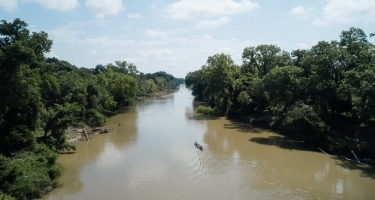
Labyrinth of Hell
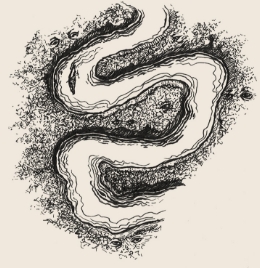

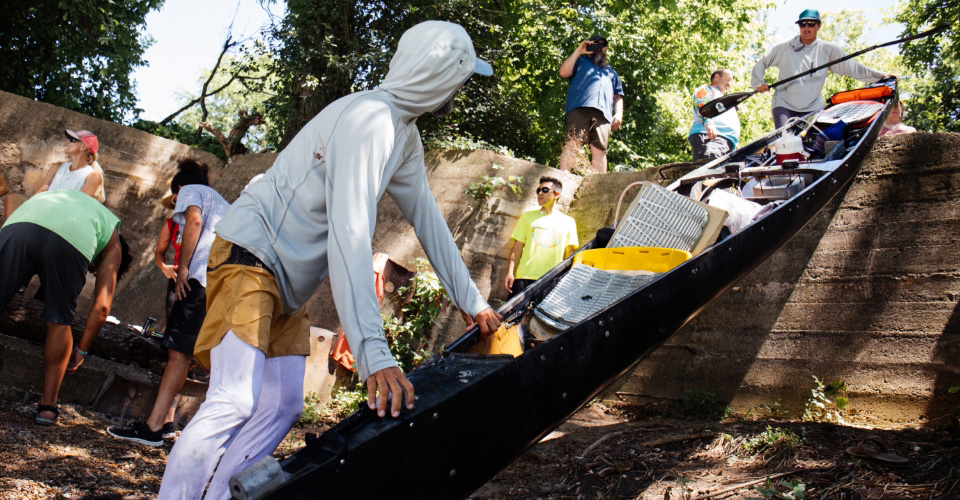
Lauren Spalding: The flight tracker says JT’s flight is delayed. I get that he wanted to guide his guests before the race and not after, but it’s hurricane season and he’s in the Bahamas. This is not looking good. I’ve got to get some sleep, so if he does make it, one of us is rested.
Race Day – 2:00 AM
JT Van Zandt: I made it from Abaco to Houston, but ended up driving from Houston to Austin since I missed the last connection. There’s a camera guy and his gear in my kid’s room. There are a couple guys in the guest room, another on the couch. Lauren is in a room. My wife and kids, plus Lauren’s 9-month-old girl are comfortably elsewhere. I’m exhausted, but also amped up. I’d better try to sleep – three hours is better than nothing…
5:00 AM
JT: “Alright, let’s do this” I say, flipping on the lights in the house. I never really slept. And I didn’t get quality rest in Abaco either, drinking rum and partying on a fishing trip for six days before this. But I can’t let that get to me. This race is all about mindset.
6:00 – en Route to San Marcos
Lauren: I just want to be positive. I agreed to the race because I want to attempt something like this at least one time in my life to really see how bad the suffering can be. My only expectation is to finish the race. And not go crazy.
San Marcos River Headwaters:
Aquarena Springs – 8:00 AM
JT: “Lauren, you’re getting some comments about that giant paddle,” I say, ribbing her. For the Hawaiian open-ocean outrigger canoe paddling races that she does, she’s got the best paddle you can get. But canoe marathoners on rivers typically use short little carbon-fiber paddles since they don’t cost you much energy. “Yeah, but the bigger the scoop, the faster you can go if you have the strength to keep it up,” she says. If anyone has the strength to keep it up, it’s Lauren.
9:00 AM – RACE START
Lauren: “What is that, JT?” “It’s Spiz,” he says – basically an energy drink powder with fat in it for marathon performance. “Chocolate mixed with vanilla isn’t terrible,” he explains. Yeah, I ain’t touching that, I decide. I’ve got my gel packs and snacks. I’m good.
9:15 AM
Lauren: Oh my god, that was chaos. I’ve never seen anything like it. We were about fourth from the very last in the back of the pack, gunnel to gunnel with 300 other boats in very tight quarters. Disasters happened all around us; people were t-boning and almost dumping. But we sliced through all of them. We passed about two-thirds of the crowd in that first 250 yards, putting us in the top third of the paddlers.
~1000 Meters from Start – First Portage
Lauren: It’s like a scene from “The Last of the Mohicans” over here, everyone running through the bushes and down steep embankments with their heavy canoes. JT tells me there’s something like 80 frickin’ portages on the first day.

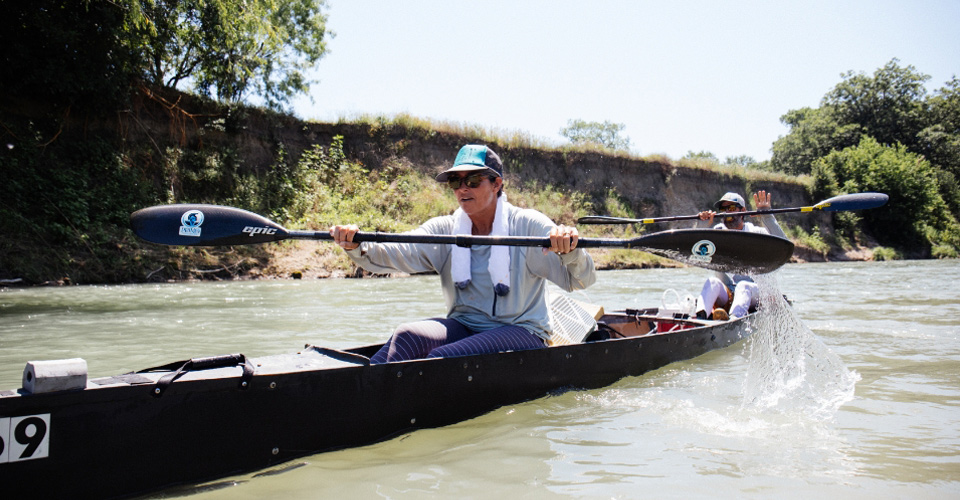
JT: We wreck at the rapids, dumping all our stuff in the river. We’re scrambling, gathering it up and bailing the water out. This guy and his wife (22-year race veterans, and they have won the mixed race about 10 times) pass us, saying, “Thanks for picking up all that trash out of our river! We sure appreciate that.”
We get dried out and are paddling full on to make up lost time. We pass them.
CHECKPOINT 1: Staples Dam
DISTANCE FROM START: 16.62 miles
Note: Competitors must make it to this checkpoint by 3:00 PM or else they must tap out of the race.
Lauren: We make it to the first checkpoint in good time and rendezvous with our team captain, Marat. He reminds us, “Stay positive, there are no problems. Embrace the pain. It will end. What do you want to eat at the next checkpoint?”
Mile 23
JT: The real pros have a system of eating that won’t cost them a paddle stroke. They can one-arm paddle while they rip open a pouch or put a hard-boiled egg in their mouth. Chris Champion – a solo competitor we’re becoming buddies with – has this down. He’s got tons of tiny plastic baggies, with 12 M&Ms in one, shaved almonds in another, crushed up potato chips in another. He’s taking them like shots.
Lauren calls “hut,” and I snap back into focus, switching paddling sides. Even though she’s in the bow of the canoe and it’s unconventional, it’s already a habit from her paddling career, and it works for us, unless I forget to switch.
Mile 35-ish
Lauren: The pack is starting to space out now and we’re deep in the Texas wilderness. Traffic has become crickets, locusts, owls, and gators. The adrenaline of being around other paddlers tapers off. In the twilight it starts to get eerie, but I’m trying to keep it positive. We got this.
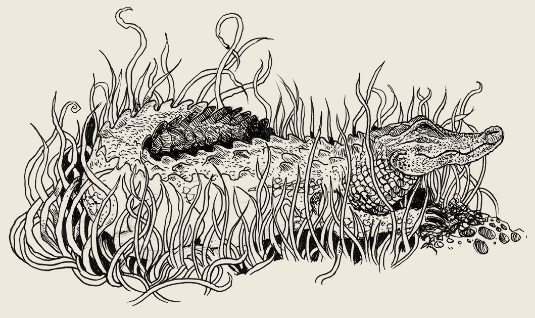
Mile 50
JT: We spend the first evening and into the night chatting away. Still feeling good and in control. We get slight relief from the heat, and paddling at night and hearing the oncoming rapids is exciting. A little scary but manageable.

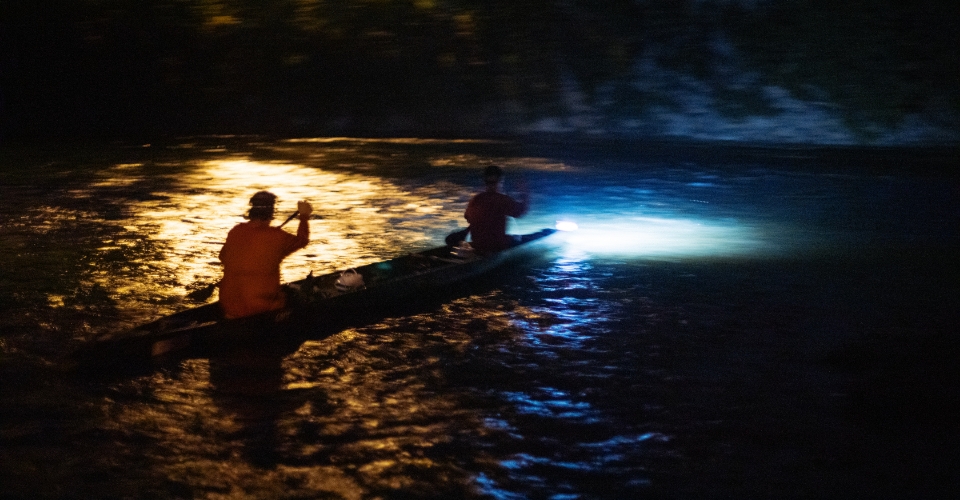
JT: We’re on a grueling 20-mile stretch. I’m in the most pain at this point. From experience, I know as I lose my mind, it somehow gets easier physically.
CHECKPOINT – Hochheim Park
DISTANCE FROM START: 122.6 miles
JT: It’s about 6:00 AM. In our 3-minute exchange, Marat hands off coffees, egg sandwiches, and tube socks filled with ice to wear around our necks – a godsend in the Texas heat. We keep stops as brief as possible.
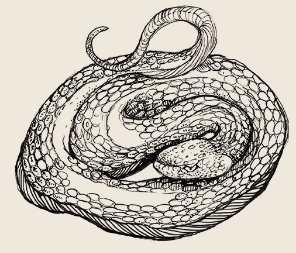
Mile 130-ish
Lauren: The first 120 miles, about 30 hours or so, were twisty, through narrow, shallow water, and getting in and out of the boat, portaging through back creeks and channels filled with spiders, snakes, and gators. JT’s trying to tell me it’s going to get more intense.
JT: The race starts in crystalline spring water. As you progress towards the ocean, it becomes less and less hospitable. The river rises and becomes more and more cruel. In the heat of the second day, fatigue gnaws at your mind and your body.
Mile 140
JT: Our friend Gaston (with his 15 year old daughter) says he overheard that couple who passed us at our wreck saying, “She’s got to be dying by now with that big paddle. They’re going to burn out. We’ve got to pass them.” But Gaston confirms on the SPOT satellite tracker that we’ve got about a 3-hour lead on them.
"I'M TELLING MYSELF I ONLY SEE REAL THINGS. BUT THESE TREES ARE SPYING ON US. I LIKE DAYTIME BETTER."
-LAUREN SPALDING
Hallucination Alley
Mile 205
Lauren: “JT, I can’t see anything.”
It’s twilight now and we’re heading into the intestine of the river with dim lights. I can’t see which direction we need to go. Exhausted from no sleep and over 30 hours of exertion. The first night wasn’t bad. It’s different now. JT tells me to “Look up and find the ‘v’ the trees form against the sky. Follow the ‘v’.”
Mile 212
JT: “Are we going the wrong way? Could we have turned around?”
Lauren: “*Bleep*, I hope we’re not paddling backwards … no. No, have faith. We’re going the right direction. What the … is that a body!? Floating? Do you see that?”
JT: She’s hallucinating. But I’m looking at something else, watching what I think is a boat transform into a horse, then a log. But I do see a light. “Lauren, that’s Chris Champion. We need to follow him.”
People can end up spending 10-12 hours lost in the channels if they make a wrong turn, thinking they were taking a shortcut. I knew Chris had practiced this route. It’s crucial we don’t lose him, especially in the dark.

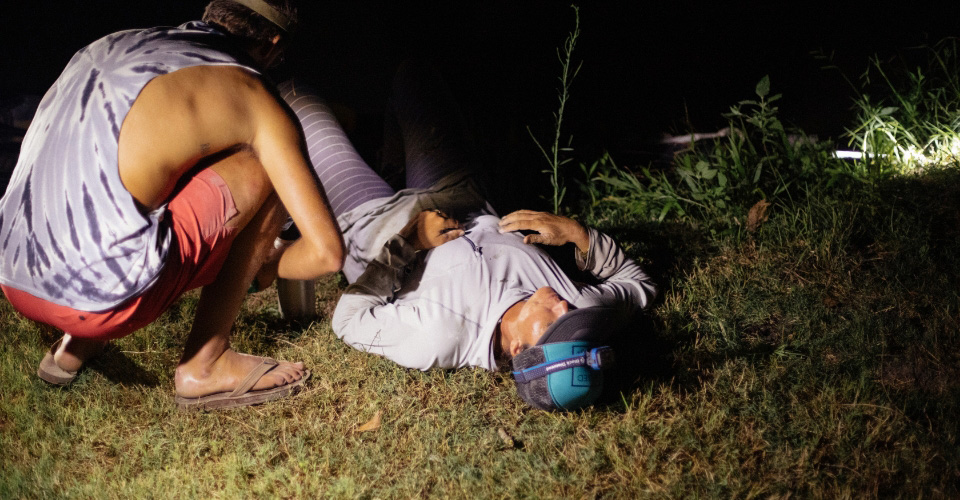
Lauren: Chris is jamming through this thing. We’re going harder than we’ve gone in 100 miles to keep up. I don’t have 10 hours in me to spare.
JT: Don’t stop to eat. No sips of water. We’re cramming through these little crevasses of limbs that scrape our faces off if we don’t lay back. We see Chris’ light up ahead around the curve … it looks like aliens are landing, and their lights are bouncing through this aqua forest. We keep following.
Lauren: The trees are spying on us. I like daytime better. I’m telling myself I only see real things.
What’s Chris doing up there? Shit, this log jam isn’t on the map.
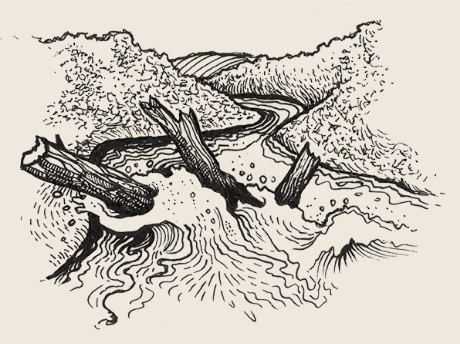
Mile 225 – Log Jam
JT: Chris is trying to get over this small little area off to the right. But I see a different spot we’re going to try to punch through.
Lauren: “Oh my God, there’s a gator under me. It’s making so much noise.”
JT: “A gator?...*Bleep* it. This is the smallest spot – we’re going to punch through.”
Lauren: JT’s a madman. We ram the canoe into the log. He sounds like an angry pirate. We have to get out of the canoe, into the water with the gator. I’m running on caffeine gel packs. I haven’t stood up in hours. I think my legs might give out in this mud.
JT: Lauren just fainted out in the woods. I look back after moving some logs and I see her slumped over. Then she bolts awake.
Lauren: “Oh my god, I don’t want to be stuck in the middle of the Texas jungle! Where’s the Spiz? Give me the *bleep* Spiz!” Oh, but it felt so nice to have my eyes closed.
JT: I haul the canoe over the log, then help her up and back into the canoe. On land, I thought she needed to see a doctor. But put a paddle in her hands and she snaps up. My legs aren’t even in the boat, and she’s already scooping.
The best feeling in the world is to be paddling again because the landscape is a thorny, viney, snake- and alligator-ridden mess. And the damn mosquitoes. They will destroy you.
Chris got stuck back there. Even though we leaned on him more than he may know, the race rules say you can receive no help. We had no choice; it felt like a double cross. But we had to keep going.

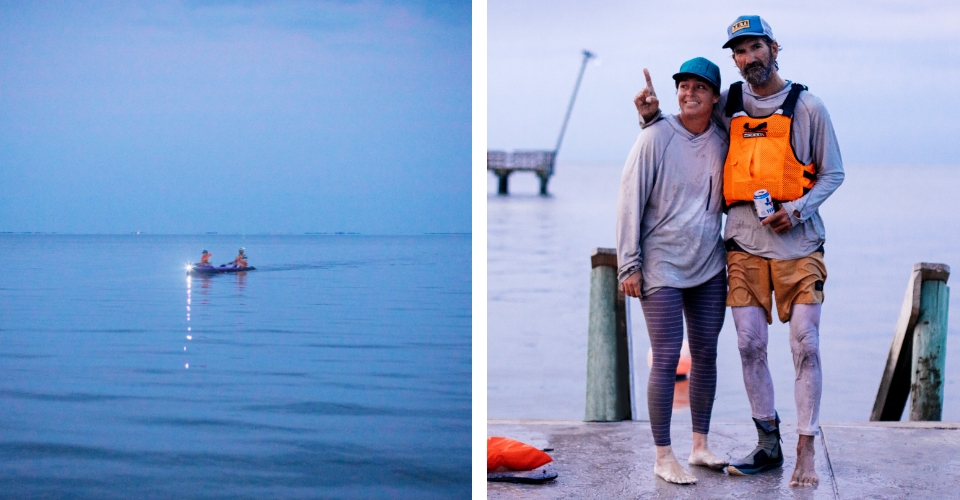
JT: “Give me the aerosol, Marat! These *bleep* *bleep* mosquitoes!”
I’m in the water. I can't get the damn spray skirt back on. I don’t have the strength to make it happen. I’m screaming mad. I’m not going to lose this race because of a spray skirt. “MARAT, THE AEROSOL!”
Lauren: The spray skirt doesn’t matter – we’ll just bail the boat if we need to. Let’s go. We don’t want to head into the ocean without a skirt on, but we’re going on 12 minutes at this checkpoint. We have 20 miles left. We need to go.
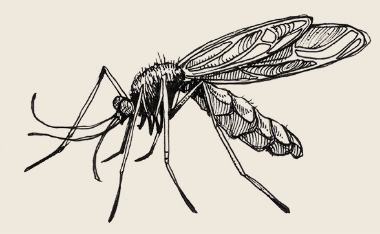
Mile 259
JT: If you haven’t done this before, you enter the bay not knowing where the finish line is. If it’s dark out like it still is now in the early morning, you can’t see what’s coming at you – could be a glass bay, could be 4-5 foot waves. But this water is where I guide, and the ocean is Lauren’s home. We have a distinct mental advantage.
Lauren: I’m so glad to be back in the ocean – finally something familiar. Seven miles. Let’s go.
"I LOVE THAT IT'S AN OLD SCHOOL APPRECIATION FOR HARD WORK. YOU FINISHED THE RACE? GOOD. YOU ENTERED IT - THAT'S WHAT YOU WERE SUPPOSED TO DO."
-LAUREN SPALDING
JT and Lauren finished the race in 45 hours and 7 minutes, coming in at 6:07 AM Monday morning before the sun came up.
They came in first place in the “Mixed” division, beating the second place finisher in this category by 45 minutes. Most competitors stay at or return to the finish to cheer on the incoming finishers. They have until Wednesday at noon to finish.
JT: This race teaches you what it’s like to have your tank at true empty. It’s a way we, the average people who aren't Everest-bound, can test our will to survive. To do it, you must stay positive and connect with something greater than yourself. The community who competes include soldiers who come home to find peace in nature through exertion. They’re cancer survivors, families competing in memory of someone. They’re fathers with their daughters, and they’re friends looking to show their pal from Hawaii a little bit of Texas.
Lauren: Hats off to anyone who does this race and completes it. There’s no prize money. The trophy is symbolic. You take home a patch. I love that it’s an old-school appreciation for hard work. You finished the race? Good. You entered it – that’s what you were supposed to do.
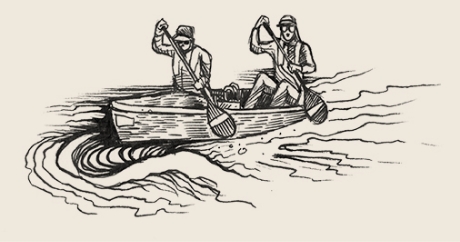
Texas Water Safari
The Texas Water Safari has been running for nearly 70 years, a race with few requirements and almost no reward, except that of the personal gratification that comes from testing oneself in nature, staying alive, and finding out what you’re capable of.
The race traverses over 260 miles of challenging rivers and bays, with true Texas hazards, like fire ants, snakes, gators, mosquitos the size of birds, and relentless summer heat. But within the journey is a community of humble hard workers, families, veterans, cancer survivors, first-timers, and those who dedicate their year o training, prepping, and competing in the race. While it is competitive, like Lauren and JT, many participants enter with the goal of simply finishing, earning the prized Texas Water Safari finisher’s patch.
To compete, volunteer, or cheer on this year’s race participants, visit TexasWaterSafari.org





